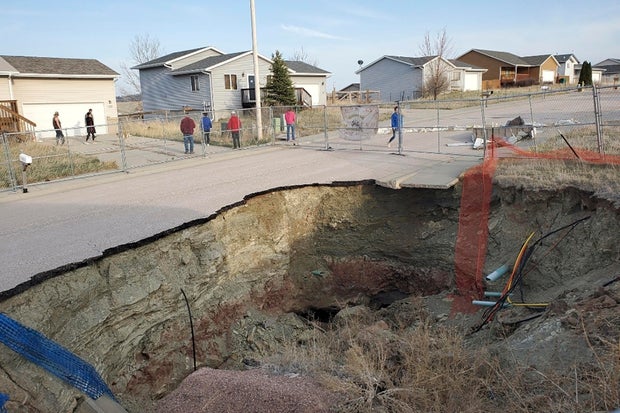CBS News
Giant sinkholes in a South Dakota neighborhood leave some families “panicked and stuck”

Stuart and Tonya Junker loved their quiet neighborhood near South Dakota‘s Black Hills – until the earth began collapsing around them, leaving them wondering if their home could tumble into a gaping hole.
They blame the state for selling land that became the Hideaway Hills subdivision despite knowing it was perched above an old mine. Since the sinkholes began opening up, they and about 150 of their neighbors sued the state for $45 million to cover the value of their homes and legal costs.
“Let’s just say it’s really changed our lives a lot,” Tonya Junker said. “The worry, the not sleeping, the ‘what if’ something happens. It’s all of it, all of the above.”
Sinkholes are fairly common, due to collapsed caves, old mines or dissolving material but the circumstances in South Dakota stand out, said Paul Santi, a professor of geological engineering at the Colorado School of Mines. The combination of such large sinkholes endangering so many homes makes the Hideaway Hills situation one to remember.
“I can say just from having taught classes about case histories with geologic problems that this would be a case that will end up in textbooks,” Santi said.
Tonya Junker via AP
Crews built Hideaway Hills, located a few miles northwest of Rapid City, from 2002 to 2004 in an area previously owned by the state where the mineral gypsum was mined for use at a nearby state-owned cement plant.
Attorney Kathy Barrow, who represents residents who live in 94 subdivision homes, said the state sold the surface but held on to the subsurface and it did not disclose it had removed the soil’s natural ability to hold up the surface.
Some of the land slightly sunk over time after the subdivision was built, and a hole opened up beneath a back porch, but the situation escalated after a large sinkhole opened up in 2020 near where a man was mowing his lawn. That prompted residents to connect with Barrow and testing revealed a large, improperly sealed mine beneath the northeastern part of the subdivision, and a 40-foot-deep (12-meter-deep) pit mine in another corner of the neighborhood, Barrow said.
Since that first giant collapse, more holes and sinkings have appeared and there are now “too many to count,” Barrow said. The unstable ground has affected 158 homes plus destabilized roads and utilities.
In one spot, an old truck can be seen in a hole beneath a house porch, still resting where a landowner pushed it into a mine cavern in the 1940s, Barrow said.
The area near the 2020 collapse has been vacated and gated off, but people still live in many of the other homes, usually because they can’t afford to leave.
Residents are panicked but stuck, Barrow said.
“They’re worried about school buses falling into a hole. They worry about their houses collapsing on their children in their beds at night,” Barrow said. “I mean, you spend your whole life putting money and building equity in your home. It’s your most prized asset, and these people’s asset had become not only worthless but almost a negative because they’re dangerous to live in.”
An attorney for the state declined to comment, but the state has asked a judge to dismiss the case.
In court documents, the state entities being sued said they “would like to express their sincerest sympathies for many of the property owners” and called the sinkhole formation “tragic.”
Still, the state argued that it wasn’t the fault of officials.
Tonya Junker via AP
“Those truly liable in this case are the developer, the initial realtor, and the numerous homebuilders who knowingly chose to build over an abandoned mine while purposefully hiding its existence from the homebuyers purchasing in Hideaway Hills,” the state said.
In court documents, the state traced the area’s mining history to the 1900s, noting a company that mined underground and on the surface before 1930. Beginning in 1986, the state-owned cement plant mined for several years.
The state claimed it wasn’t liable for damages related to the underground mine collapse because the cement plant didn’t mine underground and the mine would have collapsed regardless of the plant’s activities. Around 1994, a horse farmer bought the land and then later sold the property to a developer who encountered a deep hole, the state said in documents.
The state said it couldn’t have known that the developer, homebuilders and the county would move ahead with the neighborhood’s development despite allegedly knowing about the past mining and underground voids.
In 2000, the South Dakota Legislature approved the sale of the state cement plant. A voter-approved trust fund created from proceeds of the sale stands at over $371 million.
For the Junkers, the lawsuit is their best hope of escaping from a nightmare.
Tonya Junker said her husband was going to retire this year, but now he has to work longer, taking on two jobs to save money in case they are evacuated.
“That’s a hard pill to swallow,” she said.
The Junkers have lived 15 years together in the neighborhood, in a home built in 1929 and moved to the subdivision as one of the first homes in the neighborhood. They gutted and remodeled the structure and planned to make the three-bedroom, two-bathroom home their base for retirement.
Stuart Junker said he simply wants to be paid what his house is worth.
“It’s just kind of disappointing that the state won’t take care of us,” he said. “I mean, this is their problem.”
CBS News
Taste-testing “Sandwiches of History” – CBS News

Watch CBS News
Be the first to know
Get browser notifications for breaking news, live events, and exclusive reporting.
CBS News
“Sandwiches of History”: Resurrecting sandwich recipes that time forgot

Barry Enderwick is eating his way through history, one sandwich at a time. Every day from his home in San Jose, California, Enderwick posts a cooking video from a recipe that time forgot. From the 1905 British book “Salads, Sandwiches and Savouries,” Enderwick prepared the New York Sandwich.
The recipe called for 24 oysters, minced and mixed with mayonnaise, seasoned with lemon juice and pepper, and spread over buttered day-old French bread.
Rescuing recipes from the dustbin of history doesn’t always lead to culinary success. Sampling his New York Sandwich, Enderwick decried it as “a textural wasteland. No, thank you.” Into the trash bin it went!
But Enderwick’s efforts have yielded his own cookbook, a collection of some of the strangest – and sometimes unexpectedly delicious – historical recipes you’ve never heard of.
Harvard Common Press
He even has a traveling stage show: “Sandwiches of History Live.”
From the condiments to the sliced bread, this former Netflix executive has become something of a sandwich celebrity. “You can put just about anything in-between two slices of bread,” he said. “And it’s portable! In general, a sandwich is pretty easy fare. And so, they just have universal appeal.”
Though the sandwich gets its name famously from the Fourth Earl of Sandwich, the earliest sandwich Enderwick has eaten dates from 200 B.C.E. China, a seared beef sandwich called Rou Jia Mo.
He declared it delicious. “Between the onions, and all those spices and the soy sauce … oh my God! Oh man, this is so good!”
While Elvis was famous for his peanut butter and banana concoction, Enderwick says there’s another celebrity who should be more famous for his sandwich: Gene Kelly, who he says had “the greatest man sandwich in the world, which was basically mashed potatoes on bread. And it was delicious.”
Whether it’s a peanut and sardine sandwich (from “Blondie’s Cook Book” from 1947), or the parmesian radish sandwich (from 1909’s “The Up-To-Date Sandwich Book”), Enderwick tries to get a taste of who we were – good or gross – one recipe at a time.
RECIPE: A sophisticated club sandwich
Blogger Barry Enderwick, of Sandwiches of History, offers “Sunday Morning” viewers a 1958 recipe for a club sandwich that, he says, shouldn’t work, but actually does, really well!
MORE: “Sunday Morning” 2024 “Food Issue” recipe index
Delicious menu suggestions from top chefs, cookbook authors, food writers, restaurateurs, and the editors of Food & Wine magazine.
For more info:
Story produced by Anthony Laudato. Editor: Chad Cardin.
CBS News
The cream of the crop in butter

Watch CBS News
Be the first to know
Get browser notifications for breaking news, live events, and exclusive reporting.










